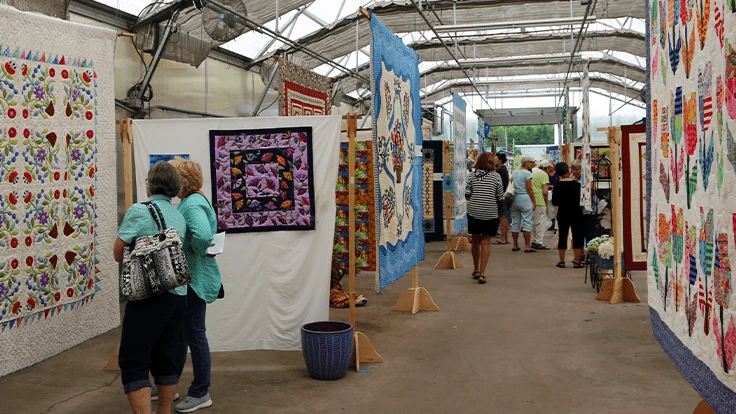

Every garden center enters the doldrums at certain times of the year. Your IGC can be crazy busy in the spring, but in mid-summer, the wind might leave your sails. When doing your event planning for the coming year, consider the periods when the pace is slower as the perfect time to draw in new people.
One way to attract a crowd of new customers is with arts and crafts. This is a partnership that serves all involved. Many artisans and craftspeople are looking for places to showcase and sell their work. They are also used to joining together with others, and most have a mailing list, website and social networks for promoting their appearances.
Garden centers often have greenhouses or outdoor spaces that are empty at particular times of the year, so these can be used for fairs and exhibits. Here are some of the considerations for partnering with artists and crafters.
What works for you?
The first thing to decide is how you want such an event to run and how it can benefit your IGC. For example, do you want the goods sold to be garden or flower-related, for example? If there is a theme that can amplify your business or stock? By all means, ask that your arts and crafters have at least some items that fit in. Perhaps you’d like to feature plants for pollinators, to give one example. In that case, asking for vendors who can highlight bees, birds and butterflies would be logical.
Are there items that craftspeople might sell that compete with your own merchandise? For example, if you stock sun hats in your store, you probably don’t want a vendor who makes sun hats. If it’s close to the holidays, and you sell ornaments, it’s not in your business’s best interest to have crafters that are only selling ornaments.
Think of the time of year you’re holding the event and what the public is interested in during that season. Use this and your regional knowledge about customers to set the theme for such an event. In my area on Cape Cod, we have an annual hydrangea festival in July. In 2021, we had a quilt exhibit during that period, and the quilts shown were all garden- or plant-themed. Because the Cape Cod Hydrangea Festival promoted this event in their calendar listings, we were able to get publicity from the fest as well as the quilters’ guild who used our space. And, of course, we had hydrangeas to sell.
Finding participants
There are several ways to locate possible craftspeople and artisans. The easiest is to work with a local arts or crafts organization, and organize who is showing. In these cases, coordinate with one event organizer from the group, outlining your needs and specifications. They do the rest for selecting exhibitors and communicating with those artisans moving forward.
If you need to find vendors on your own, post in places such as Craigslist, Facebook or the Nextdoor app. You can also alert local crafts schools or studios as well. When doing so, be sure to include all of the relevant details about the date, times and criteria for applying. The more details you include, the fewer random questions you’ll have to answer moving forward. Include the call for entries in your newsletter and on your website as well. Word of mouth is huge; you’ll be surprised at the number of people who have a friend or family member that might be interested in participating.
Juried or come one, come all?
If you’re finding individual crafters and artists to participate, set aside time to choose the vendors. Do you want them to submit photos of their work by email? Is there a theme that you want to emphasize? Will you have a range of crafts or art for sale with a variety of price points? Are you looking to attract an audience with a focused interest? These decisions need to be made months in advance to have adequate time to review the submissions. Some events might draw only a few interested artisans, while others could attract over a hundred applicants.
Another consideration is the weather. If the vendors are going to be outdoors, will they be required to protect themselves from sun and rain? Many craftspeople have pop-up tents or booths, but the IGC should be clear about where those shelters will be placed. How much space are you allowing each vendor? Will they be able to secure tent poles or stakes into the ground, or will the event be on hard cement or asphalt? These decisions need to be made before your call for participants because they’ll influence who applies.
Charge or trade for space?
Many organizers of craft fairs charge the participants for having a space, so it is an option for IGCs to ask for a nominal fee. This ensures that the crafters take their commitment to appear seriously. It’s also possible to ask the participants for a $50 deposit check, which will be returned to them at the end of the event but cashed if they decide not to come. Whether you charge or offer free spaces, be sure to ask those who are showing to promote the event through their newsletters and social media. Request that they link those posts to the event planner at your garden center.
If a guild or other local group is organizing who appears, they will take charge of deciding who shows, if there’s a fee to participate and if non-members can apply. They will also remind the artisans before the event and coordinate with the IGC about setup and takedown dates and times.

ADOBE STOCK
Maximizing the event for sales
Once the theme, dates and location are in place, you can plan for how your store can maximize sales. You might give attendees a coupon for a discount on certain items that day. Maybe you want to have your own “tent sale” with items at a deep discount. Or, instead of enticing people with bargains, use the event to open their eyes to your most special merchandise and services. Have your staff designer in a booth give garden or plant advice and pass out information about your design and build services. Have a booth that showcases your custom planters or specialty plants. Or create a display of plants and products that fits the show’s theme, placing that at the entrance to the show.
Don’t forget to use the event to build your own mailing list. Have a drawing for a few nice prizes and ask for emails as the way people can enter. You might also give people a call-back coupon that they can use on another date or in another season. If you have a rewards program, be sure to have a table where people can get details and sign up.
Showtime!
Know that an event will take your staff’s involvement before, during and after an event. You’ll need to clear the area, blow off debris, mark off exhibitor spaces or help the guild do so. You might need to provide signage that directs people to your cashiers and the restrooms. If food is involved, you’ll need to comply with the local health department’s rules regarding hand-washing stations or requirements. And if more people will be coming through your store, you might need additional staff on hand for parking directions, customer assistance or security.
Events such as this take a good amount of planning in order to run smoothly and benefit your IGC, and January is the perfect time to get organized.


Explore the January 2022 Issue
Check out more from this issue and find your next story to read.
Latest from Garden Center
- Dümmen Orange North America celebrating 25th anniversary in 2025
- Illinois Landscape Contractors Association changes name to Landscape Illinois
- 2025 Proven Winners Horticulture Scholarship applications now open
- Leading Women of Horticulture: Arden Pontasch, North Creek Nurseries
- Spring Meadow Nursery's Freedom Shelley finds joy in plants
- Leading Women of Horticulture: Dana Massey, Plantworks Nursery
- Meet the Next Gen: Gabriella Blair, Star Roses and Plants
- Leading Women of Horticulture: Katie Dubow, Garden Media Group, and Aubry Field, Lizzy Blossom





